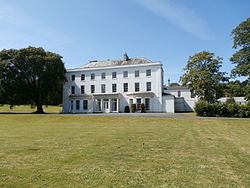Moreton House, Bideford
| Moreton House | |
| Devon | |
|---|---|
 Moreton House | |
| Location | |
| Grid reference: | SS43612630 |
| Location: | 51°-0’53"N, 4°13’51"W |
| Village: | Bideford |
| History | |
| Country house | |
| Information | |
Moreton House (formerly until 1821 Daddon House is a country house, once the centre of a large estate near Bideford, in north Devon.
The house is about one mile west of the old centre of Bideford town, its entrance drive leading off the south side of the road between Bideford and the village of Abbotsham. It is a Grade II listed building,[1] In recent years the estate has become increasingly surrounded by the suburbs of Bideford, and in 2014 only five acres of the former parkland remain attached to the house.
The estate is said anciently to have been the property of the famous Grenville family, lords of the Manor of Bideford, and of Stowe, Kilkhampton in Cornwall. It was later acquired by the Buck merchant family of Bideford, which rebuilt the house in 1760 and again in 1821. In 1858 the Buck family changed its name to Stucley,[2] in order to succeed to an inheritance from a recent female ancestress and heiress.
The Stucley family sold Moreton House in 1956, after which it was occupied by Grenville College, a private school, which vacated the site in 2009.
The house is a fine example of Georgian architecture and had at one time ornate gardens with two lakes, fountains, waterfalls and formal herbaceous borders. The house with five acres of land was offered for sale in 2014 for the surprisingly low price of £500,000 and reached national prominence when the Daily Mail newspaper pointed out that a small one car garage in Kensington, Middlesex, was at that time for sale at the same price as the 28-bedroom Moreton House. The estate agent explained the low price by saying that the house was "too big" (at 34,250 square feet., 28 bedrooms, 19 reception rooms, a ballroom and eight bathrooms).
The house's former name is memorialised by an industrial estate called "Daddon Court" a short distance to the south of the house.
History



The family of Buck were Bideford ship owners and merchants who from the 17th century traded with the American colonies and owned tobacco plantations in Virginia and a saw-mill in Bideford, Maine, and from their profits they acquired much land near their naïve Bideford: eventually by the end of the 18th century their estates almost surrounded the north side of the town from Westleigh to Northam.[3]
George Buck (1731–1794) inherited the estate in 1755, with much additional land. He rebuilt Daddon House in about 1760, and made it his residence. The irregular plan indicates that some of the fabric of the older structure was retained. He acquired the advowson of Bideford from the heirs of William Henry Granville, 3rd Earl of Bath (1692–1711), the last Grenville lord of the Manor of Bideford. It was inherited by his son, George Pawley Buck.
The Rev John Swete visited Daddon House during the time of George Pawley Buck.[4]
Lewis William Buck (1784–1858) is believed in 1821 to have undertaken further building work at Daddon House and to have changed the name to ‘Moreton House’. He entertained Benjamin Disraeli at Moreton House, but before he became Prime Minister in 1868, thus after Lewis's death. He had a distinguished political career but died before Disraeli became Prime Minister: his son was made a baronet; in some way a recompense for his father’s never achieving the high office which he might have achieved had the span of life permitted.[5]
Sir Hugh Nicholas Granville Stucley, 4th Baronet (1873–1956), made substantial alterations to Moreton House.[6] His personal interests were fishing, shooting and landscape gardening and it was he who designed the beautiful gardens for which Moreton House was formerly well known.
From 1939 to 1945 during the Second World War, Moreton House became the temporary home of King's Mead Preparatory School, which moved from its premises in Seaford in Sussex. Sir Hugh moved to the lodge house and looked after those boys who were too young to be boarders at the school.[7]
Sir Dennis Frederic Bankes Stucley, 5th Baronet (1907–1983) sold off most of his estates in Britain and moved to Rhodesia, where he died in 1965. The house remained in the family however until sold to Grenville College.
Grenville College
Moreton House was sold by the Stucley family and became part of Grenville College, a private school. The gardens used to be maintained and were open to visitors at certain times. At about this time various other houses were built in the grounds of the house, such as Scott House and Crabbe House. The school playing fields were situated on the surrounding estate, but since the school's closure this land has been built over as a housing development.
References
- ↑ Moreton, Bideford - British Listed Buildings
- ↑ Vivian, p.723
- ↑ Stucley, Sir Dennis, 5th Baronet, "A Devon Parish Lost, A new Home Discovered", Presidential Address published in Transactions of the Devonshire Association, no. 108, 1976, pp. 1–11
- ↑ Journals of the Reverend John Swete (published in Travels in Georgian Devon: The Illustrated Journals of Reverend John Swete, 1789-1800, ed. Todd Gray & Margery Rowe, 1999)
- ↑ Lauder, p,146
- ↑ Stucley Sir Dennis, bt: "History of Moreton House" "(newspaper/magazine cutting) source unknown)", quoted in listed building text
- ↑ King's Mead Preparatory School: Moreton House
- Lauder, Rosemary, Devon Families, Tiverton, 2002, Stucley family, pp. 142–150
- Vivian, Lt.Col. J.L., (Ed.) The Visitations of the County of Devon: Comprising the Heralds' Visitations of 1531, 1564 & 1620, Exeter, 1895, Stucley & Buck pedigree, pp. 721–3